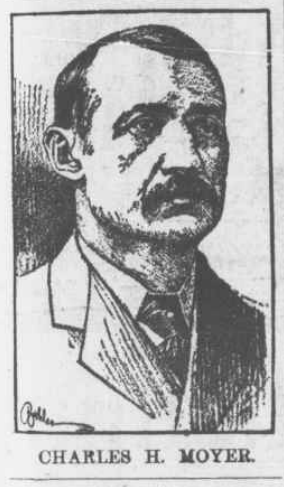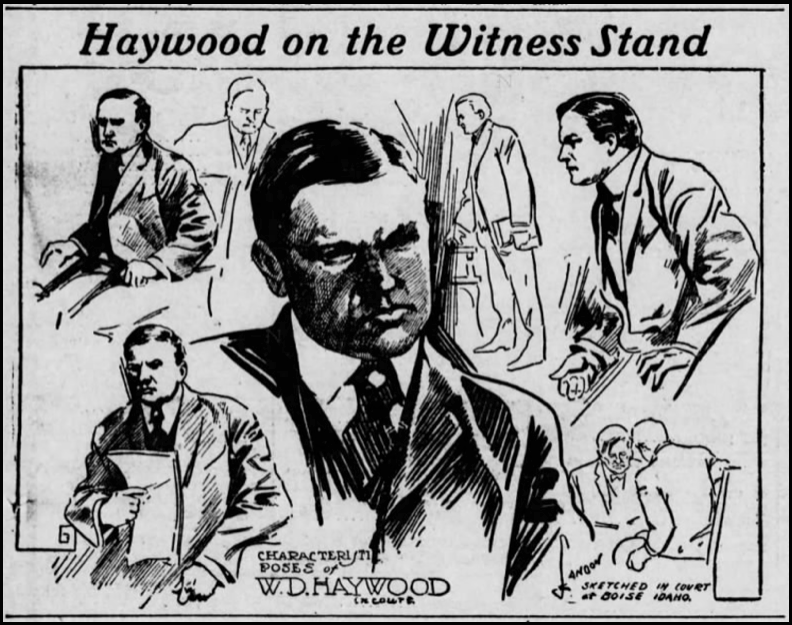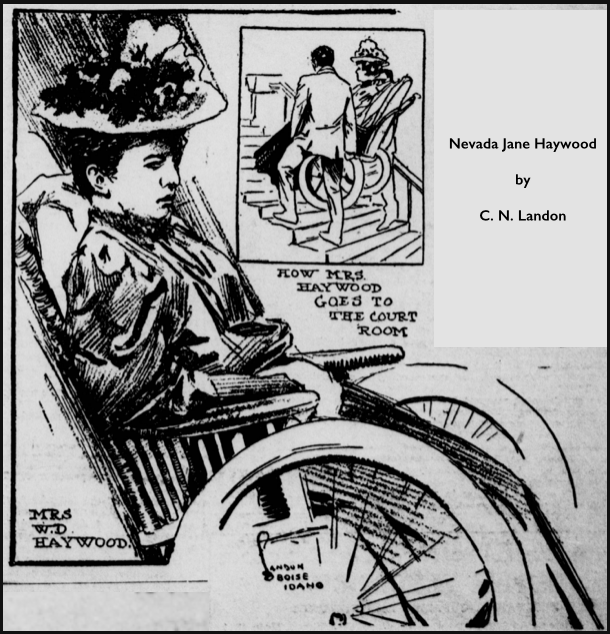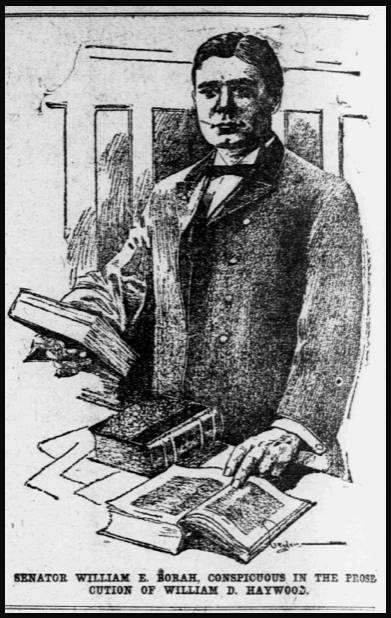If one man has a dollar he didn’t work for,
some other man worked for a dollar he didn’t get.
-Big Bill Haywood
~~~~~~~~~~~~~~~~~~~~~~~~~~~~~~~~~~~~~~~~~~~~~
Hellraisers Journal, Saturday July 20, 1907
Boise, Idaho – The Testimony of Big Bill Haywood
Ida Crouch-Hazlett of the Montana News has been in the town of Boise covering the trial of Big Bill Haywood, Secretary-Treasurer of the Western Federation of Miners. She provides us with a first-hand account of Fellow Worker Haywood on the witness stand under cross examination by Senator Borah:
…Haywood is the socialist of the three accused men. From his reading and study he understands something of the historic function of the working class. He has nothing in common whatever with the capitalist class and its ideals. His whole make-up and inclination is to knock the stuffing out of the system that oppresses him….
As he gave his testimony every socialist felt that there was the man who was speaking the instinctive aspiration and determination of the working class….
[Drawing added.]
We have also provided reporting from the Daily Capital Journal of Salem, Oregon, of July 12th:
WANTED TO SEE BORAH’S EYES
Haywood [while being cross-examined by Borah] gave an indication of his coolness by asking that the window shutter be closed, explaining that he could not see Borah’s eyes, because of the sun’s glare.
From the Montana News of July 18, 1907:
Haywood’s Testimony
—–Tells of His Connection With Union in
Straight Forward Way—
Makes a Good ImpressionBoise, July 13.
Thursday afternoon the man who is being tried for his life was put on the stand. Haywood’s manner was quiet and self sustained. He gave his answers in a cool matter-of-fact way that gave little opportunity for Borah’s bulldozing. The local papers fairly bristle with accounts of Haywood’s nervousness, his blundering and incriminating answers, and how he has sustained Orchard’s allegations in every particular except the admission of the crimes.
Such tales are absolutely fantastical. Haywood has acquitted himself with the greatest credit, and his plain straightforward story has had a visible effect on all that were privileged to hear him.
In this drama of greed versus human life Haywood seems someway to represent superlatively the typical proletarian element.
Marxian students may remember a passage in the “Eighteenth Brumaire” where Marx decides the difference between bourgeois revolutions and proletarian revolutions. He speaks of the brilliancy, confidence and rapid consummation of bourgeois revolutions, and of how slow and halting are proletarian movement. The later lack confidence, move forward with a rush, are thrown back, but keep gathering again and again.
The typical proletarian lacks confidence when brought into direct contact with bourgeois conventionalities. He does not fit into the artificial conditions with which capitalism has hedged itself around for its own protection and perpetuation. The working man may be courageous, aggressive, even brilliant in dealing with the affairs of his own class, but when he touches capitalism he touches a different civilization from that which he and his fellows are moving forward to realize in the world’s history.
Haywood is the socialist of the three accused men. From his reading and study he understands something of the historic function of the working class. He has nothing in common whatever with the capitalist class and its ideals. His whole make-up and inclination is to knock the stuffing out of the system that oppresses him. So aggressive is he by nature that when assaulted by the soldiers at the union depot in Denver, when he went to shake hands with Moyer after his imprisonment, he fought the whole company, and only ceased his own self-protection when overwhelmed by numbers, and brutal beating.
As he gave his testimony every socialist felt that there was the man who was speaking the instinctive aspiration and determination of the working class. Even though bound, beaten, imprisoned and hanged, even though he had committed every crime that the mine owners have brought to his door-still he is ours, fighting the fight of his class against the shameful and unrighteous slavery of all who do the work.
Haywood is 38 years old. He related the circumstances of his early life, his marriage, how his wife’s invalid condition began after the birth of the youngest child. As these sad memories were brought up one after the other, the patient wife begins sobbing, but is soothed by the mother and quiets herself.
Haywood joined the Western Federation with the union in Silver City, Idaho, where he was a charter member. He was appointed to write the resolution of his union on the Coeur d’Alenes trouble, and wrote it in the mine on the bottom of a candle box. Borah showed much curiosity in regard to this resolution, and asked for a copy of it, and if it could be found in the files of the Miners’ Magazine.
It will be remembered that a man by the name of Stewart from Silver City testified that during the reign of terror in the Coeur d’Alenes Haywood had said that Steunenberg ought to be exterminated. Haywood said that this fellow was the only scab in the camp, and that his own language had been that Steunenberg ought to be relegated and that he had helped to relegate him politically.
When asked as to his personal feeling towards Steunenberg, he said he regarded him the same as every other politician-swayed by capitalist interests.
He told at some length of the purposes for which the union was formed, of meeting Orchard first at the Denver convention of 1904, called for the unions of the state to consider the political situation. He denied that he or the Federation had ever had any dealings with Orchard except in a general way as any other member.
In giving the history of the Cripple Creek strike he said the unions had established the stores in self defense after the merchants had refused credit to the miners and raised the price of their goods.
As in the case of Moyer’s testimony Borah laid particular stress upon how the Federation came to take up Orchard’s case after he was arrested for the murder of Steunenberg. The papers had stated that a postal card addressed to Moyer was found in Orchard’s suit case. Within two or three days after the crime the papers announced that the W. F. M. was responsible because of Steunenberg’s connection with the Coeur d’Alenes troubles.
It had been the custom of the Federation from the beginning to find lawyers and money at once when information was received that the Federation was being attacked, as was being done all the time and in every conceivable way by the wolfish mine owners. They are always waiting, ready to spring at the throat of the unions on the slightest pretext. It is only through the strength of the mutual protection and watchfulness that the organizations of the working class can live at all.
On the cross examination Borah dwelt particularly on the feeling in the Federation against Steunenberg. Haywood said they looked upon him as one hostile to labor, and untrue to his oath of office.
Haywood was questioned in regard to all the methods of the unions for their protection as though they were crimes against society. And it was more and more evident to the careful observer that the arch crime that the unions commit is lessening the profits of the men that hire labor.
IDA CROUCH-HAZLETT
———-
[Drawing added.]
———-

Haywood’s testimony was proceeded by that of Charles Moyer, President of the Western Federation of Miners. His testimony was also covered on the front page of the this week’s edition of the Montana News. Ida Crouch-Hazlett describes his presence on the stand while under cross-examination by Borah:
…Moyer’s replies were cool, quiet, courteous, even respectful. He easily had the upper hand in the give and take. It was plainly to be seen that Borah was making superlative efforts to fasten the responsibility of Steunenberg’s murder upon the Western Federation through the admission of its president.
But President Moyer was ready at every trap. His answers were convincing, solid and dignified. He is far the heaviest witness the defense has put up. The Western Federation of Miners has made no mistake during these years in its choice of a head….
From the Salem Daily Capital Journal of July 12, 1907:
…..Haywood’s direct examination was completed at 10:20, [on July 12th] and Borah cross-examined him. The early part of the cross-examination was devoted to detailing Haywood’s connection with the federation as a member and as an officer.
He said he knew little about the blowing up of the Bunker Hill and Sullivan mine; but that he knew all about Steunenberg’s action in the arrest and bull-penning of residents of the district. Haywood here gave an indication of his coolness by asking that the window shutter be closed, explaining that he could not see Borah’s eyes, because of the sun’s glare. “You regarded Steunenberg as directly responsible for all these outrages, did you?” asked Borah. “Oh, no,” was the reply. “I never regarded Steunenberg any differently than [I?] did you, Bartlett Sinclair or others who were on that side,” said Haywood. The witness insisted that his criticism of Steunenberg referred to his official and not his personal character and acts….
[Drawing added.]
SOURCES
Montana News
“Owned and Published by the
Socialist Party of Montana”
(Helena, Montana)
-July 18, 1907
http://chroniclingamerica.loc.gov/lccn/sn84024811/1907-07-18/ed-1/seq-1/
Daily Capital Journal
(Salem, Oregon)
-July 12, 1907
http://chroniclingamerica.loc.gov/lccn/sn99063957/1907-07-12/ed-1/seq-1/
IMAGES
HMP, Hy on witness stand, Landon, Spk Prs, July 12, 1907
HMP, Nevada Jane Haywood, Landon, Spk Prs, July 12, 1907
http://chroniclingamerica.loc.gov/lccn/sn88085947/1907-07-12/ed-1/seq-1/
HMP, Charles Moyer, CdA ID Press, July 11, 1907
http://chroniclingamerica.loc.gov/lccn/sn88056096/1907-07-11/ed-1/seq-1/
HMP, BBH and Borah’s Eyes, OR Dly Cp Jr, July 12, 1907
http://chroniclingamerica.loc.gov/lccn/sn99063957/1907-07-12/ed-1/seq-1/
HMP, Borah for Prosecution, Pensacola Jr, July 14, 1907
http://chroniclingamerica.loc.gov/lccn/sn87062268/1907-07-14/ed-1/seq-4/
See also:
Tag: Haywood Trial of 1907
https://weneverforget.org/tag/haywood-trial-of-1907/
Darrow Collection: Haywood Trial
http://moses.law.umn.edu/darrow/trials.php?tid=3
Trial Transcripts, Haywood Trial, Volume 7, pp 3380 – 3722
July 8, 9 1907.
Note: pdf, slow to load.
http://moses.law.umn.edu/darrow/documents/Haywood_Transcripts_vol_7_pp_3380_3722_Combined.pdf
Trial Transcripts, Haywood Trial, Volume 8, pp 3722 – 4041
July 10th & 11th 1907.
http://moses.law.umn.edu/darrow/documents/Haywood%20Transcript.pdf
Trial Transcripts, Haywood Trial, Volume 9, pp 4042 – 4302
July 12, 13 1907.
http://moses.law.umn.edu/darrow/documents/Vol_9_Haywood_Transcript_p_4042_4302.pdf
The Eighteenth Brumaire of Louis Bonaparte by Karl Marx
https://www.marxists.org/archive/marx/works/1852/18th-brumaire/
Bill Haywood’s Book
The Autobiography of William D. Haywood
-by Big Bill Haywood
International Publishers, 1929
https://catalog.hathitrust.org/Record/000859708
See Chapter XIII-The Boise Trial
https://babel.hathitrust.org/cgi/pt?id=mdp.39015050276461;view=image;page=root;size=100;seq=211;num=207
Page 213: Borah’s eyes:
During his cross-examination the sun was sinking and shining through a window toward which I was facing. I said to the judge, “If your Honor please, will you kindly have the shutters closed on that window? The sun is shining in my face and I cannot see the senator’s eyes.”
It was not my intention to disconcert the senator, but I was told afterward that he said he had never heard of a man on trial for his life who was so anxious to see the prosecutor’s eyes. He said, “It doubled me up like a jack-knife!”
Am providing both Rebel Graphics and Google Books versions of this book as both versions are easily searchable in different ways.
The Cripple Creek Strike by Emma F Langdon
-from Rebel Graphics (RIP FW Richard Myers)
Note: Links on the left can be used for more information on subjects mentioned above. Also, scroll down to Appendix for links to the Haywood-Moyer-Pettibone Case.
http://www.rebelgraphics.org/wfmhall/langdon00.html
The Cripple Creek Strike: A History of Industrial Wars in Colorado, 1903-4-5; Being a Complete and Concise History of the Efforts of Organized Capital to Crush Unionism
-by Emma Florence Langdon
Great Western Publishing Company, ab/ 1908
Note: this edition contains coverage of Haywood Trial, and was therefore published later than 1905.
(Search: with names mentioned above.)
https://books.google.com/books?id=olgpAAAAYAAJ
For more on the Coeur d’Alene bullpen:
The Class War in Idaho
The Horrors of the Bull Pen
-by Job Harriman
NY, 1900
https://archive.org/stream/classwarinidahoh00harrrich#page/n5/mode/2up
The Story of the Bull Pen At Wardner, Idaho
-by Thomas A Hickey
SLP, 1900
http://moses.law.umn.edu/darrow/documents/Bull_Pen_remember_the_bullpen_opt_cropped.pdf
Tells the story of the Miners’ struggles in Idaho in 1892 and 1899, of the bull pen of 1899 where men were kept under conditions so harsh that three of them died. Tells of the death of Union Miner Mike Devine in Governor Steunenberg’s bullpen.




